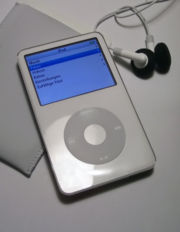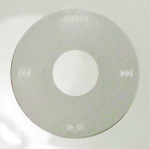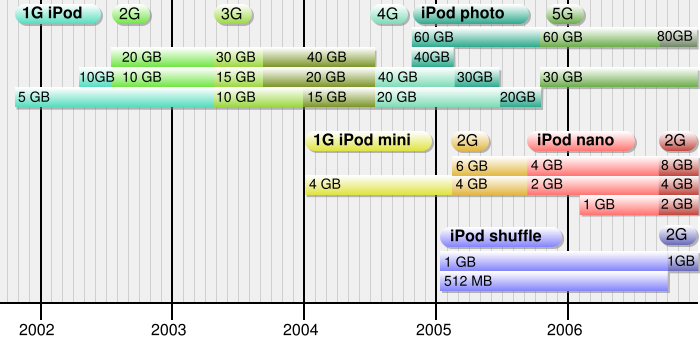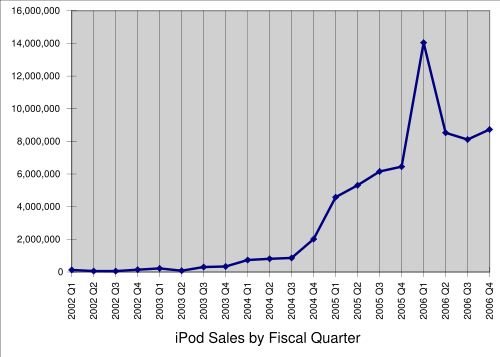IPod
2007 Schools Wikipedia Selection. Related subjects: Computing hardware and infrastructure; Engineering
- The correct title of this article is iPod. The initial letter is shown capitalized due to technical restrictions.
iPod is a brand of portable media players designed and marketed by Apple Computer and launched in 2001. Devices in the iPod range are primarily music players, designed around a central scroll wheel (although the iPod shuffle has buttons only). The full-sized model stores media on an internal hard drive, while the smaller iPod nano and iPod shuffle use flash memory. Like many digital audio players, iPods can also serve as external data storage devices. Apple chose to focus its development on the iPod's simple user interface and its ease of use, rather than on technical capability. The only iPod that does not have a screen built in is the iPod shuffle. The iPod shuffle is named that because it has a switch allowing the songs to be shuffled so they are not in order. Later, all iPods were given this functionality through a software command.
As of October 2005, the lineup consists of the video-capable fifth generation iPod; the smaller iPod nano; and the display-less iPod shuffle. These models were updated in September 2006.
The bundled software used for transferring music is called iTunes. As a jukebox application, iTunes stores a comprehensive library of music on the user's computer and can play, burn, and rip music from a CD. It can also sync photos and videos.
The iPod is currently the world's best-selling digital audio player and its worldwide mainstream adoption makes it one of the most popular consumer brands. Some of Apple's design choices and proprietary actions have, however, led to criticism and legal battles.
History and design
The iPod came from Apple's digital hub strategy, as the company began creating software for the growing market of digital devices being purchased by consumers. While digital cameras, camcorders and organizers had well-established mainstream markets, the company found digital music players lacking in user interface design and decided to develop its own. "iPod" was a name that Apple registered for Internet kiosks, but never put to use.
Apple's hardware engineering chief Jon Rubinstein assembled a team of engineers to design it, along with engineers Anthony Fadell and Stan Ng. They built the product in less than a year, and it was unveiled on 24 December 2001. CEO Steve Jobs announced it as a Mac-compatible product with a 5 GB hard drive that put "1000 songs in your pocket."
Jonathan Ive (Senior Vice President of Industrial Design at Apple Computer) led the team that designed the iPod, which has established Apple as the dominant presence in the mp3 player market.
Uncharacteristically, Apple did not develop the iPod's software in-house. Instead, Apple used a Design Chain and contracted with PortalPlayer, who already had a reference design (based on 2 ARM cores) with rudimentary software running on a commercial microkernel embedded operating system. PortalPlayer had previously been working on an IBM-branded MP3 player with Bluetooth headphones. Apple contracted another company, Pixo, to create and refine the user interface, under the direct supervision of Steve Jobs.
Once established, Apple continued to refine the software's look and feel. Starting with the iPod mini, the Chicago font (once used on early Macintosh computers) was replaced with Espy Sans, which was originally used in eWorld and Copland. The most recent iPods switched fonts again to Podium Sans — a font similar to Apple's corporate font Myriad. The iPods with colour displays have adopted some Mac OS X themes like Aqua progress bars and brushed metal in the FM tuner and lock interfaces.
User interface
The recent iPods with displays use high quality anti-aliased graphics and text, with sliding animations. These iPods have five buttons: and newer generations have the buttons integrated into the scroll wheel, an innovation which gives an uncluttered, minimalistic interface. The buttons are:
- Menu — to traverse backwards through the menus, and toggle the backlight on older iPods
- Centre — to select a menu item
- Play / Pause — this doubles as an off switch when held
- Fast Forward / Skip Forward
- Fast Reverse / Skip Backwards
The other operations such as scrolling through menu items and controlling the volume are handled by the scroll wheel in a rotational manner, with clockwise denoting downward movement and counterclockwise signaling upward movement. The first generation used a "Scroll Wheel" that physically turned, with the buttons clustered around it. The second generation replaced it with a "Touch Wheel" that reacts to human capacitance. The third generation rearranged the buttons, but the touch wheel was left in place. On the fourth generation iPods forward, and all minis and nanos, the buttons are integrated directly into the wheel, now called a "Click Wheel". The wheel is still used for scrolling, and buttons, which must be physically pressed, control playback. This innovation gives an uncluttered, minimalistic interface.
The iPod shuffle 1st and 2nd generation are the only 2 iPods without a screen and consequently its five buttons function differently than the larger models. It has a Play / Pause button in the centre, surrounded by four buttons; two control volume while the other two control track skipping.
A Hold switch on the top of all iPods prevents accidental button presses. Newer iPods automatically pause playback when the headphones are unplugged from the headphone jack, but playback does not resume when the headphones are re-inserted. An iPod that has crashed or frozen can be reset by switching 'Hold' on then off, then holding Menu and Centre (Menu and Play on the 3G iPod) for 6 seconds.
Software
The iPod can play MP3, AAC/ M4A, Protected AAC, AIFF, WAV, Audible audiobook, and Apple Lossless audio file formats. The fifth generation iPod can also play MPEG-4 ( H.264/MPEG-4 AVC), .mp4 and QuickTime video formats, with restrictions on video dimensions, encoding techniques and bitrates. Apple does not support Microsoft's WMA audio format — unlike most other media players — but a converter for non-DRM WMA files is provided with the Windows version of iTunes. MIDI and Ogg Vorbis files cannot be played on the iPod, but can be converted to audio files using the "Advanced" menu on iTunes. Alternative open-source audio formats such as FLAC are not supported.
Each time an iPod connects to its host computer, iTunes can synchronize music playlists or entire music libraries and the user can choose for automatic or manual synchronization. Song ratings can be set on the iPod and synchronized later to the iTunes library.
iTunes Store
The iTunes Store (formerly iTunes Music Store) is an online media store run by Apple and accessed via iTunes. It was introduced on 29 April 2003 and it sells individual songs relatively easily and cheaply, with typical prices being US$0.99, EU€0.99, or GB£0.79 per song. iPods are the only portable music players that can play the purchased music. TV episodes and sometimes TV movies are available for $1.99, though prices vary. The store became the market leader soon after its launch and Apple announced the sale of videos through the iTunes Store on 12 October 2005. Full-length movies became available on 12 September 2006, ranging in prices from US$9.99-$14.99.
Purchased audio files use the AAC format with added encryption. The encryption is based on the controversial FairPlay digital rights management (DRM) system. Up to five authorized computers and an unlimited number of iPods can play the files. Burning the files onto an audio CD removes the DRM, at a cost of reduced quality when re-compressed from one lossy format to another.
iPods cannot play music files from other competing music stores such as Napster or MSN Music which use rival DRM technologies like Microsoft's protected WMA or RealNetworks' Helix DRM. RealNetworks claims that Apple is creating problems for itself, by using FairPlay to lock users into using the iTunes Store. Steve Jobs stated that Apple makes little profit from song sales, but Apple uses the store to promote iPod sales.
File storage
All iPods can function as mass storage devices to store data files. If the iPod is formatted on a Mac OS X computer it uses the HFS Plus file system format. If it is formatted on Windows, the FAT32 format is used because Windows cannot access HFS filesystems. The user must use iTunes or a compatible third-party software to load audio, videos, and photos in such a way that they are playable and viewable on the iPod. Unlike PlaysForSure-compatible and other MP3 players, simply copying files to the drive will not allow the iPod to properly access them. Some third party iPod software allows this however.
An iPod formatted as HFS Plus is able to serve as a boot disk for a Mac computer, allowing one to have a portable operating system installed. The older iPods with FireWire ports could additionally function in FireWire Disk Mode. With the advent of the Windows-compatible iPod, the iPod's default file system was switched from HFS Plus to FAT32, although they can be reformatted to either filesystem (excluding the iPod shuffle which is strictly FAT32). By default, windows-installed ipods are formatted in the FAT32 file system.
iTunes cannot transfer songs or videos from device to computer (although iTunes 7 allows it for music purchased online). The media files are stored on the iPod in a hidden folder, together with a proprietary database file. The hidden content can be accessed on the host operating system by enabling hidden files to be shown. The audio can then be recovered manually by dragging the files or folders onto the iTunes Library or by using third-party software.
Additional features
The larger models also have limited PDA-like functionality and can display text files. Contacts and schedules can be viewed and synchronized with the host computer, and some built-in games are available including Brick, Parachute, Solitaire and Music Quiz. Brick (which is a clone of Breakout) was originally invented by Apple co-founder Steve Wozniak in the 1970s.
A firmware update released in September 2006 brought several new features to 5th generation iPods including downloadable games, adjustable screen brightness, and gapless playback.
Connectivity
Originally, a FireWire connection to the host computer was used to update songs or recharge the battery. The battery could also be charged with a power adapter that was included with the first 4 generations.
The third generation began including a dock connector, allowing for FireWire or USB connectivity. This provided better compatibility with PCs, as most of them did not have FireWire ports at the time. However, the device could not be charged over USB, so the FireWire cables were nonetheless needed to connect to the AC adapter. The dock connector also brought opportunities to exchange data, sound and power with an iPod, which ultimately created a large market of accessories, manufactured by third parties such as Belkin and Griffin. The 2nd generation iPod shuffle uses a single 3.5 mm jack which acts as both a headphone jack and a data port for the dock.
The fourth generation iPod allowed recharging via USB and eventually Apple began shipping iPods with a USB to Dock connector cable instead of a FireWire cable. A FireWire cable was available separately from Apple however. The fourth generation iPod could use either FireWire 400 or USB 2.0.
As of the 5th generation iPod, Apple has discontinued using FireWire for information transfers preferring USB 2.0 due to the broader popularity of the port over FireWire; this change was greatly eased by the similar transfer rates between the two types of connection. However, FireWire is still supported for charging the iPod, and Apple offers FireWire cables for purchase.
Chipsets and electronics
| Model | Storage medium | Microcontroller | Audio chip |
|---|---|---|---|
| iPod 1G, 2G, 3G | 1.8 inch, 4200rpm (46 mm) ATA hard drives (with proprietary connectors), made by Toshiba | Two ARM 7TDMI-derived CPUs running at 90 MHz. | Various audio codecs manufactured by Wolfson Microelectronics |
| iPod 4G, 5G | Variable speed ARM 7TDMI CPUs, running at a peak of 80 MHz to save battery life. | ||
| iPod mini 1G, 2G | 1 inch Microdrives manufactured by Hitachi | ||
| iPod nano 1G | Flash memory from Samsung, Toshiba and others | 2 ARM 7TDMI CPUs @ 80 MHz | |
| iPod nano 2G | Samsung System-On-Chip, based around an ARM processor | ||
| iPod shuffle | Flash memory | SigmaTel STMP3550 chip that handles both the music decoding and the audio circuitry. | |
The iPod's operating system is stored on its dedicated storage medium. An additional NOR flash ROM chip (either 1 MB or 512 kB) contains a bootloader program that tells the device to load its OS from the storage medium. Each iPod also has 32 MB of RAM, although the 60 and 80 GB fifth generation have 64 MB. A portion of the RAM is used to hold the iPod OS loaded from firmware, but the majority of it serves to cache songs from the storage medium. For example, an iPod could spin its hard disk up once and copy about 30 MB of upcoming songs into RAM, thus saving power by not requiring the drive to spin up for each song.
The current iPod models use internal lithium-ion batteries. The first and second generations used lithium polymer batteries. The larger models use touch wheels provided by Synaptics.
On 26 April 2006, EE Times reported that Samsung had won the contract to provide the media processor for a future model iPod, replacing Apple's previous design supplier PortalPlayer.
iPod models
| Model (and generation) | Image | Capacity | Changes introduced | Connection | Original release date | Launch price (US$) | |
|---|---|---|---|---|---|---|---|
| iPod | 1G | 5, 10 GB | First release. The mechanical scroll wheel physically turned. | FireWire | 23 October 2001 | $399, $499 | |
| 2G | 10, 20 GB | Touch sensitive wheel. The FireWire port had a cover. | FireWire | 17 July 2002 | $399, $499 | ||
| 3G | 10, 15, 20, 30, 40 GB | Dock Connector port introduced; this became the standard for all future iPods. Central row of touch sensitive buttons. | FireWire (USB for syncing only) | 28 April 2003 | $299, $399, $399, $499 | ||
| 4G / photo | 20, 30, 40, 60 GB | Buttons integrated to "Click Wheel". Colour display with photo viewer introduced in October 2004 and replaced the monochrome model in June 2005. | FireWire or USB | July 2004 | $299, $349, $399, $599 | ||
| 5G | 30, 60, 80 GB | Slimmer design. Larger screen with video player and lyrics support. Introduced in white and for first time, black. No AC adapter, Universal Dock, or A/V cables included. The September 2006 revision featured a brighter display, longer video battery life, and a music search function. The 80GB model was introduced to replace the 60GB model, which was discontinued. |
USB (FireWire for charging only) | 12 October 2005 | $299, $399 (later $249, $349) | ||
| iPod mini | 1G | |
4 GB | First release. Available in 5 colors. | USB or FireWire | 6 January 2004 | $249 |
| 2G | 4, 6 GB | Brighter color variants with longer battery life. Click Wheel lettering matched body color. No AC adapter. . Gold colour discontinued. | USB or FireWire | 22 February 2005 | $199, $249 | ||
| iPod nano | 1G | 1, 2, 4 GB | First release. Successor to the iPod mini. Slimmer design with flash memory, colour screen and lyrics support. | USB (FireWire for charging only) | 7 September 2005 | $149, $199, $249 | |
| 2G | 2, 4, 8 GB | Anodized aluminium case in 6 colors. Brighter screen and longer battery life. | USB | 12 September 2006 | $149, $199 $249 | ||
| iPod shuffle | 1G | 512 MB, 1 GB | First release. The iPod without a screen or wheel-like input. | USB | 11 January 2005 | $99, $149 (later $69, $99) | |
| 2G | 1 GB | Aluminium case with smaller form factor., plus built-in clip. | USB (via dock only) | October 2006 | $79 | ||
Each new generation usually has more features and refinements whilst typically being smaller and lighter than its predecessor. Notable changes include the touch sensitive wheel replacing the mechanical scroll wheel, colour displays, and flash memory replacing hard disks. Discontinued models include four generations of the full-sized iPod, two generations of the iPod mini and the first generations of the nano and shuffle. More information about all released iPods is available on Apple's website.
The first generation iPods were Mac compatible only. Apple later added limited Windows support and at this time, Windows users required third-party software such as Musicmatch Jukebox, ephPod or XPlay to manage their music. Musicmatch was included on the bundled CD. From July 2004 and onwards, every iPod was made fully compatible with either Mac or Windows, after Apple released the Windows version of iTunes on 16 October 2003.
Special edition and colour variants
In December 2002, Apple unveiled its first limited edition iPods, with either Madonna’s, Tony Hawk’s, or Beck’s signature or No Doubt's band logo engraved on the back for an extra US$49.
On 26 October 2004, Apple introduced a special edition of its fourth generation monochrome iPod, designed in the colour scheme of the latest album ( How to Dismantle an Atomic Bomb) by Irish rock band U2. It had a black case with a red scroll wheel and the back had the engraved signatures of U2's band members. This iPod was updated alongside the iPod photo and fifth generation iPod.
On 13 October 2006, Apple released a special edition red 4 GB iPod nano as part of the (PRODUCT)RED campaign. Three weeks later, an 8 GB version was released and both of them sold for the same price as the standard colour models. US$10 from each sale is donated to the Global Fund to fight AIDS.
Apple has also released Special Edition Harry Potter iPods. These were engraved with the Hogwarts Crest on the back and were available only to purchasers of the Harry Potter audiobooks. They first appeared with the iPod photo (late fourth generation), and then were updated with the fifth generation iPod. They have since been discontinued.
The first generation iPod nano and fifth generation iPod were released in black and white variants. The second generation iPod nano inherited some of its case design from the mini.
Criticisms
Battery life advertising
Apple stated that the original fifth generation 60 GB and 30 GB iPods had battery lives of "up to 20 hours" and "up to 14 hours" music playback respectively, when used on controlled and limited tests. For real-world use, many users report battery lives of less than 8 hours with the 30 GB video iPod.
In 2003, class action lawsuits were brought against Apple complaining that the battery charges lasted for shorter lengths of time than stated and that the battery degraded over time. The lawsuits were settled by offering individuals either $50 store credit or a free battery replacement.
Apple later complained that its competitor, Sony, had misled consumers in its advertising for Sony's music player. Apple complained that Sony had not considered real-world usage.
Non-replaceable battery
The battery in all iPods is not designed to be removed or replaced by the user, although some users have been able to pry the case open to replace the battery, as some online stores sell them. Compounding this problem, Apple initially would not replace worn-out batteries. The official policy was that the customer should buy a refurbished replacement iPod, at a cost almost equivalent to a brand new one. All lithium-ion batteries eventually lose capacity during their lifetime (guidelines are available for prolonging life-span) and this situation led to a small market for third-party battery replacement kits.
Apple announced a battery replacement program on 14 November 2003, a week before a high publicity stunt and website by the Neistat Brothers. The initial cost was US$99, but it was lowered to US$59 in 2005. One week later Apple offered an extended iPod warranty for US$59. Third-party companies offer cheaper battery replacement kits that often use higher capacity batteries. For the iPod nano, soldering tools are needed because the battery is soldered onto the main board. On the fifth generation iPod, the battery is held onto the backplate with adhesive.
Bass response
The third generation iPod had a weak bass response, as shown in audio tests. The combination of the undersized DC blocking capacitors and the typical low impedance of most consumer headphones form a high-pass filter which attenuates the low-frequency bass output by up to 10 dB. Similar capacitors were used in the fourth generation iPods. The problem is reduced when using high impedance headphones and completely masked when driving high-impedance (line level) loads. The first generation iPod shuffle uses a dual transistor output stage rather than a single capacitor-coupled output, and thus does not exhibit reduced bass response for any load.
Equalizer
If the sound is enhanced with the iPod's software equalizer (EQ), some EQ settings — like R&B, Rock, Acoustic, and Bass Booster — can cause bass distortion too easily.
The equalizer amplifies the digital audio level beyond the software's limit, causing distortion ( clipping) on songs that have a bass drum or use a bassy instrument, even when the amplifier level is low. Notable song examples include Bob Sinclar's Love Generation and Jem's Wish I. One possible workaround is to reduce the volume level of the recorded MP3 by modifying each audio file. However, this cannot be done with DRM-encrypted music, and different tools are needed for each different file format.
Reliability, quality control
According to a 2005 survey conducted on the MacInTouch website, the iPod's reliability has generally improved for each new generation, although Apple reported that between September and October 2006, a minority of 5th generation iPods carried a virus called RavMonE.exe. The virus affects Windows operating systems and can be cleaned using anti-virus programs and with instructions from Apple's website.
The surface of the 1st generation iPod nano and of the 5th generation iPod can become scratched easily. Many users complained and a class action lawsuit was filed. Apple initially considered the issue a minor defect, but later began shipping these iPods with protective sleeves. Several products are available to remove the scratches, such as iCleaner, AppleSauce, and the metal polish Brasso.
iPods, like all portable music players, may be a potential cause of hearing loss when used for prolonged periods with the included earphones. In early 2006 a Louisiana man sued Apple claiming that the company failed to inform the public that there was a risk, if iPods were listened to for a long time at high volumes. To respond to this Apple introduced a volume limit option for 5th generation iPods and nanos, and shuffles (however shuffles must be configured in iTunes).
Worker exploitation
On 11 June 2006, a British newspaper Mail on Sunday reported that iPods are mainly manufactured by workers who earn no more than US$50 per month and work 15-hour shifts. The report stated that the five-story Longhua factory — owned by Foxconn — houses 200,000 workers, with most of them living in dormitories that house 100 people. The report also claimed that visitors were not allowed and that the plant is secured by police officers. These allegations were denied by Foxconn. Apple acknowledged that worker hours were "excessive" and said its supplier would now be enforcing a "normal" 60-hour week.
Patent disputes
In 2005, Apple Computer faced two lawsuits claiming patent infringement by the iPod and its associated technologies: Advanced Audio Devices claimed the iPod breached their patent on a "music jukebox", while a Hong Kong-based IP portfolio company called Pat-rights filed a suit claiming that Apple's FairPlay technology breached a patent issued to inventor Ho Keung Tse. The latter case also includes the online music stores of Sony, RealNetworks, Napster, and Musicmatch as defendants.
Apple's application to the United States Patent and Trademark Office for a patent on "rotational user inputs", as used on the iPod's interface, received a third "non-final rejection" (NFR) in August 2005. Also in August 2005, Creative Technology, one of Apple's main rivals in the MP3 player market, announced that it held a patent on part of the music selection interface used by the iPod, which Creative dubbed the "Zen Patent", granted on 9 August 2005. On 15 May 2006, Creative filed another suit against Apple for patent infringement with the United States District Court for the Northern District of California. Creative also asked the United States International Trade Commission to investigate whether Apple was breaching U.S. trade laws by importing iPods into the United States.
On 24 August 2006, Apple and Creative announced a broad settlement to end their legal disputes. Apple will pay Creative US$100 million for a paid-up license to use Creative's recently awarded patent in all Apple products. Creative announced their intention to produce iPod accessories by joining the Made for iPod program. Apple also said they can recoup part of its payment if Creative is successful in licensing this patent.
Sales
Since October 2004, the iPod has dominated digital music player sales in the United States, with over 90% of the market for hard drive-based players and over 70% of the market for all types of players. During the year from January 2004 to January 2005, its high rate of sales caused its U.S. market share to increase from 31% to 65% and in July 2005, the market share was measured at 74%. The release of the iPod mini helped to ensure this success at a time when competing flash-based music players were once dominant.
In its first quarter results of 2006, Apple reported earnings of US$565 million — its highest quarterly revenue in the company's history, although how much of this was attributed to iPod sales is unknown. Apple and several industry analysts have suggested that iPod users are likely to purchase other Apple products such as Mac computers.
On 8 January 2004, Hewlett-Packard (HP) announced that they would sell HP-branded iPods under a license agreement from Apple. Several new retail channels were used — including Wal-Mart — and HP-branded iPods eventually made up 5% of all iPod sales. In July 2005, HP stopped selling iPods due to unfavorable terms and conditions imposed by Apple.
iPod sales according to Apple's quarterly financial results from 2002 Q1 to the most recent data available, 2006 Q4. Sales figure below are not forecast sales. The fourth Apple Fiscal Quarter ends in September, not December; that quarter is the first of the next year. Although Apple now includes the number of iPods sold in the regular press release concerning quarterly earnings, they did not always do so in the early days of the iPod.
| Fiscal quarter | iPods sold |
|---|---|
| 2002 Q1 | 125,000 |
| 2002 Q2 | 57,000 |
| 2002 Q3 | 54,000 |
| 2002 Q4 | 140,000 |
| 2003 Q1 | 219,000 |
| 2003 Q2 | 78,000 |
| 2003 Q3 | 304,000 |
| 2003 Q4 | 336,000 |
| 2004 Q1 | 733,000 |
| 2004 Q2 | 807,000 |
| 2004 Q3 | 860,000 |
| 2004 Q4 | 2,016,000 |
| 2005 Q1 | 4,580,000 |
| 2005 Q2 | 5,311,000 |
| 2005 Q3 | 6,155,000 |
| 2005 Q4 | 6,451,000 |
| 2006 Q1 | 14,043,000 |
| 2006 Q2 | 8,526,000 |
| 2006 Q3 | 8,111,000 |
| 2006 Q4 | 8,729,000 |
| Total | 67,642,000 |
Advertising

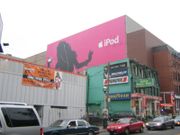
Apple has promoted the iPod and iTunes with several advertising campaigns, particularly with their silhouette commercials used both in print and on TV. These commercials feature people as dark silhouettes, dancing to music against bright-colored backgrounds. The silhouettes hold their iPods which are shown in distinctive white.
The TV adverts have used a variety of songs from both mainstream and relatively unknown artists, whilst some commercials have featured silhouettes of specific artists including Bob Dylan, U2, Eminem, Caesars and Wynton Marsalis. Successive TV commercials have also used increasingly complex animation. Newer techniques included using textured backgrounds, 3D arenas, photo-realistic lighting on the silhouette characters, and using luminescent light trails made by moving iPods .
Earphones
The iPod's white earphone cords have become symbolic of the brand, and advertisements feature them prominently. In fact, the earphones have such strong visual recognition characteristics that some have said they can be a liability. After a 24% rise in robbery and a in grand larceny in the New York City subway, a spokesperson for the NYC police suggested that iPods might be behind the increases.
Accessories
Several companies produce accessories that are designed for iPods. This market is sometimes described as the iPod ecosystem.
Some accessories add extra features that other music players have, such as sound recorders, FM radio tuners, wired remote controls, music transfer devices and audio/visual cables for TV connections. Other accessories offer more unique features like the Nike + iPod pedometer and the iPod Camera Connector. Other popular accessories include external speakers, wireless remote controls and protective cases/films that help prevent surface scratches and even wireless earphones. Notable manufacturers and resellers include Griffin, Belkin, JBL, Bose, Monster Cable and Apple.
Car integration
BMW released the first iPod automobile interface that allowed drivers of newer BMW vehicles to control their iPod using the built-in steering wheel controls or the radio head unit buttons. Apple announced in 2005 that similar systems would be available for additional vehicle brands, including Mercedes-Benz, Volvo, Nissan, Alfa Romeo, Ferrari, Acura, Audi, Honda (with speech recognition), Renault and Volkswagen.
Some independent stereo manufacturers including JVC, Pioneer, Kenwood, Alpine and Harman Kardon also have iPod-specific integration solutions. Alternative connection methods include using adaptor kits (via the cassette deck or the CD changer port), RCA inputs, or FM transmitters such as the iTrip, although personal FM transmitters are illegal in some countries.
Airliner integration
In mid-2007, six airlines ( Continental, Delta, Emirates, Air France- KLM, and United) will begin offering their passengers iPod seat connections which power and charge iPods during flight and allow the video content on their iPods to be viewed on seat back displays, integrating seamlessly with the airlines' In-flight Entertainment (IFE) system. This will also enable the IFE system to play music, television shows, or movies stored on the iPod, as well as function as a control system. In October 2006, Apple also began selling a $59 MagSafe Airline Power Adapter that plugs into an airline seat power port, allowing its MacBook or MacBook Pro notebooks (portable computers) to maintain power for the full duration of a flight.
